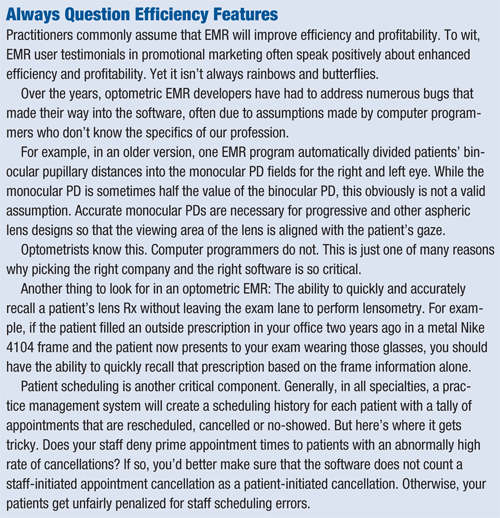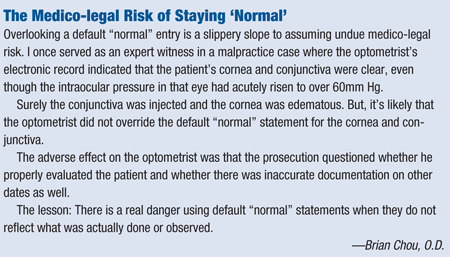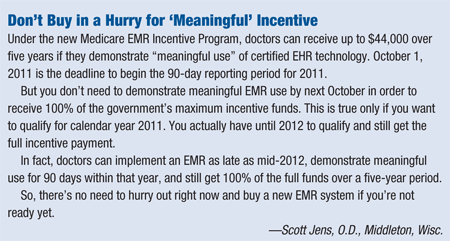If you listen to what’s said about electronic medical records (EMR)—whether in optometric publications, vendor e-mails or lectures—you might believe that EMR is a surefire ticket to improve efficiency, provide cost-savings, reduce errors and improve patient care. These stated benefits are so pervasive that it might seem unusual to think otherwise. Yet, EMR can make your life miserable if you don’t choose the right system or if you misuse the one you already have.
Many of the problems with optometric EMRs originate because computer programmers are not trained to think like optometrists, especially when it comes to medical documentation and practice operations.
Without careful and proper guidance in software development, the unfortunate result includes incorrect documentation, reduced efficiency, less profitability and compromised patient care—and even medico-legal hot water.
But you can avoid all of this. Here’s how.
First Things First

It is imperative that you select an EMR that best matches your unique practice needs. This is not a decision to take lightly because it will affect every member of your staff, every day, from here on out. Although it’s possible to switch EMRs if you have buyers’ remorse, the burden in retraining your staff and doctors is usually very high.
Due-diligence in EMR selection includes looking at the ratings and reviews for common optometric software as well as talking to colleagues who presently use EMR systems. Anecdotally, many O.D.s buy them before doing enough homework.
So, one important question to ask: How good is the customer support? Ask other O.D.s about their experiences. Good software will market itself through word of mouth.
It’s also very helpful to schedule an on-site visit to a colleague’s practice. Learn from the mistakes of others. Ask the staff how they feel about the chosen software and observe how the software is used for common transactions in the patient cycle—from registration, to pre-testing, to examination, to product selection, payment, third-party billing and reconciliation of reimbursement, and product ordering and delivery.
Next, consider if the electronic system you are evaluating suits your practice. If you have a traditional optometric practice that emphasizes glasses and contact lens fulfillment, make sure that the software you select is exceptional in this regard. If you select software that excels with medical coding and billing, but is deficient with tracking glasses and contact lens orders, your retail practice could get turned upside down.
On the other hand, if you run a vision therapy practice and routinely record binocular vision measurements, make sure that your software patterns those operations efficiently.
Otherwise, you may bitterly regret each unnecessary mouse click just to record a simple binocular vision measurement.
As a rule, you typically get what you pay for—so expect to pay more for quality software and better user experience.
Adjust Your Mindset
Successful implementation of EMR requires realistic expectations. Realize that none of the available optometric EMRs will work exactly the way you might want. Even the EMRs that have had eye care professionals closely involved in software development may use a workflow that differs from your current office operations.
Some of the workflows in the EMR are driven by data integrity standards and certification requirements for interoperability. In turn, these impositions will require you and your staff to change the way that you prepare, process and recover from patient encounters.
Once you understand that you’ll have to make fundamental changes in your office procedures and flow, it’s easier to project you and your staff into your new work lives.
Aside from work flow issues, EMRs probably won’t allow you to document patient encounters as you are doing with paper. Some will have superior documentation capabilities, while others require you to create a work-around. While it’s important to look for a product that allows you to continue in a familiar fashion, knowing that your habits will change can soften the blow of implementing EMR.
For example, how do you document drug allergies with your paper records? If you are accustomed to placing a big red sticker on the folder, you may need to come up with another attention-getting strategy for use with EMRs because some—though not all—do not display drug allergies on every page or in quite the same way you are used to, so extra diligence may be required.

Similarly, do a little research on your EMR to determine whether it perpetuates inaccurate information as a result of the manner in which you enter data. If that’s the case, you may need to start wording exam findings differently. For example, let’s suppose your EMR allows you to indicate under the patient’s ocular surgical history, “LASIK O.U. 5 years ago.” Although this is reasonable documentation, a problem manifests when, at a future examination, data is copied forward to a new exam record. While the copy-forward feature is common and intended to save time, if this patient returns in two years for another examination, the ocular surgical history would still say “LASIK O.U. 5 years ago,” even though at that time it should really indicate, “LASIK O.U. 7 years ago.”
One method to prevent perpetuating chronological inaccuracies by copying-forward is to record an absolute date for medical or ocular history (e.g., “LASIK O.U. 1995”).
Is This ‘Normal’?
Often, troublesome issues with EMRs are actually rooted in the good intention of reducing documentation time. It is critical that you are aware of these potential dangers so that you reap the benefits of speedy entry without falling victim to the hazards this could potentially create. (See “Always Question Efficiency Features”)
Some EMRs can inadvertently create false information. For example, a common strategy of EMRs is to auto-populate data fields with default “normal” findings. Malpractice lawyers have a saying that, “if it was not documented, it was not done.” However with “normal” defaults that automatically record upon creating a new exam record, it is more correct to say that, “if it was documented, it might not have been done.”
For instance, an exam record using a default that “color vision is normal” gambles on the fact that most male patients have normal color vision. So, for male patients, only about 7% require revision of the normal statement on color vision. The problem arises if a staff member forgets to perform color vision testing, because the default statement will communicate to the practitioner that the measurement was indeed performed and the result was normal.
Worse, if the patient is color blind but the staff forgets to revise the default statement about color vision, the doctor could misdiagnose the color problem altogether. (See “The Medico-legal Risk of Staying ‘Normal’”)
Another example: “routine” ophthalmoscopy through a non-dilated pupil. The EMR system may assume routine ophthalmoscopy is through dilated pupils. But if the clinician performs non-dilated ophthalmoscopy, he or she may be tempted to save a step and simply record the “normal” dilated ophthalmoscopy statement. Then, the documentation would indicate or imply that ophthalmoscopy of the retinal periphery was performed, even though it was not.
Although it’s possible to modify the “normal” default, there could be enough burden with extra mouse clicks and keystrokes that most practitioners leave that default statement alone even though it was not necessarily evaluated. The danger in using “normal” defaults is that while they’re often convenient, they can make it easy for the busy clinician to record data that he or she did not actually collect. In this manner, some functions of EMR run contrary to the practitioner’s duty to maintain an accurate exam record.

Some EMRs allow the doctor to know whether each defaulted normal statement was validated. Yet, some doctors argue that this should be taken a step further, requiring deliberate entry of individual normal findings.
Bottom line: At the very least, look at all of the default settings in the system you are considering, or the one you already have.
The Good with the Bad
The strength of EMR is that document legibility is guaranteed. No longer is there confusion whether a glasses prescription for +1.00D is actually +7.00D. The pharmacist clearly sees that the tablet is for 40mg, whereas if it were handwritten, it could be confused for 90mg. However, EMRs can still record inaccurate information, and in these cases, the information is regrettably legible and can pose dangers to the patient and practitioner.
Implementation is a monumental task, typically requiring hundreds of hours of preparation and resulting in significant stress in the workplace and, in many cases, staff turnover. To avoid this, be honest, but also try to emphasize the positives throughout the process. For example, point out to staff that when you implement EMR they’ll be doing more scanning and shredding, but will spend a lot less time locating paper charts and filing them.
Most, if not all, of the hazards associated with EMRs can be avoided with proper planning and close scrutiny of the system you select.
Dr. Chou is an industry consultant and private practitioner in San Diego. He implemented EMR in his five-optometrist practice in 2006. Dr. Warren is in private practice in Racine, Wisc. He is a co-owner of RevolutionEHR, a web-based optometric electronic health record and practice management system. Dr. Parker is in private practice in Midlothian, Va., and is the creator of
www.EHRCompare.com.

